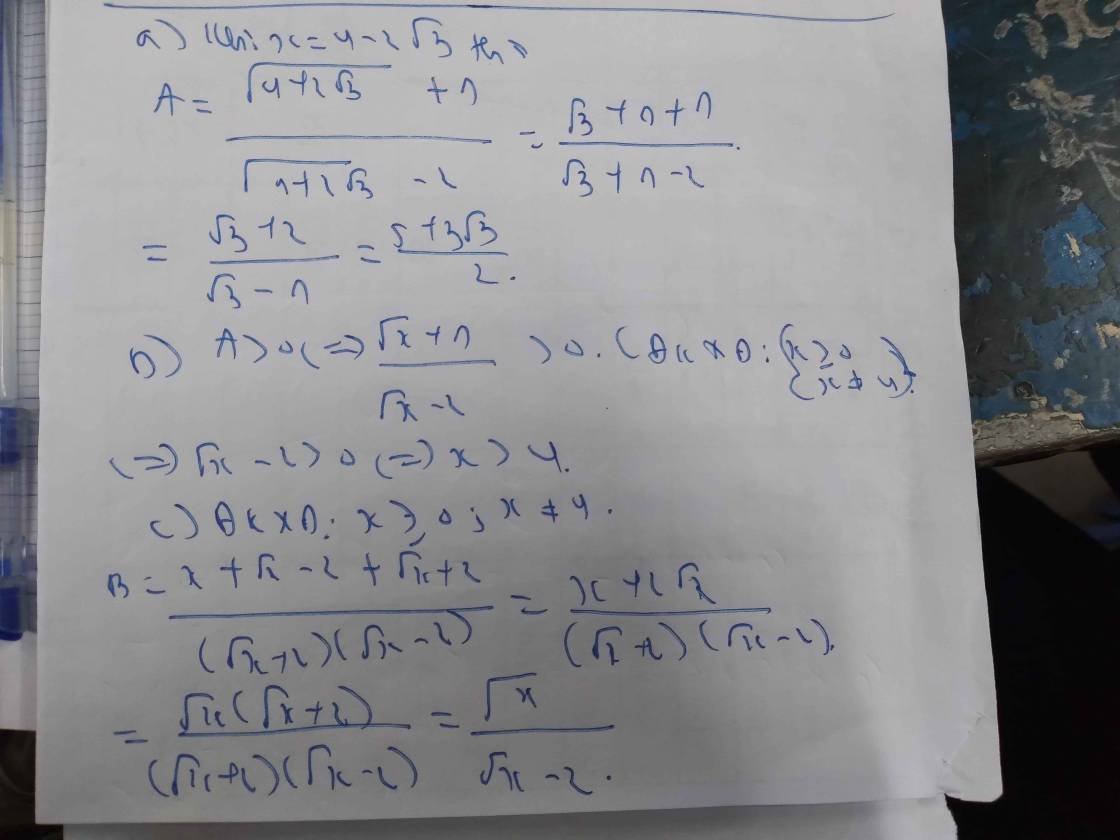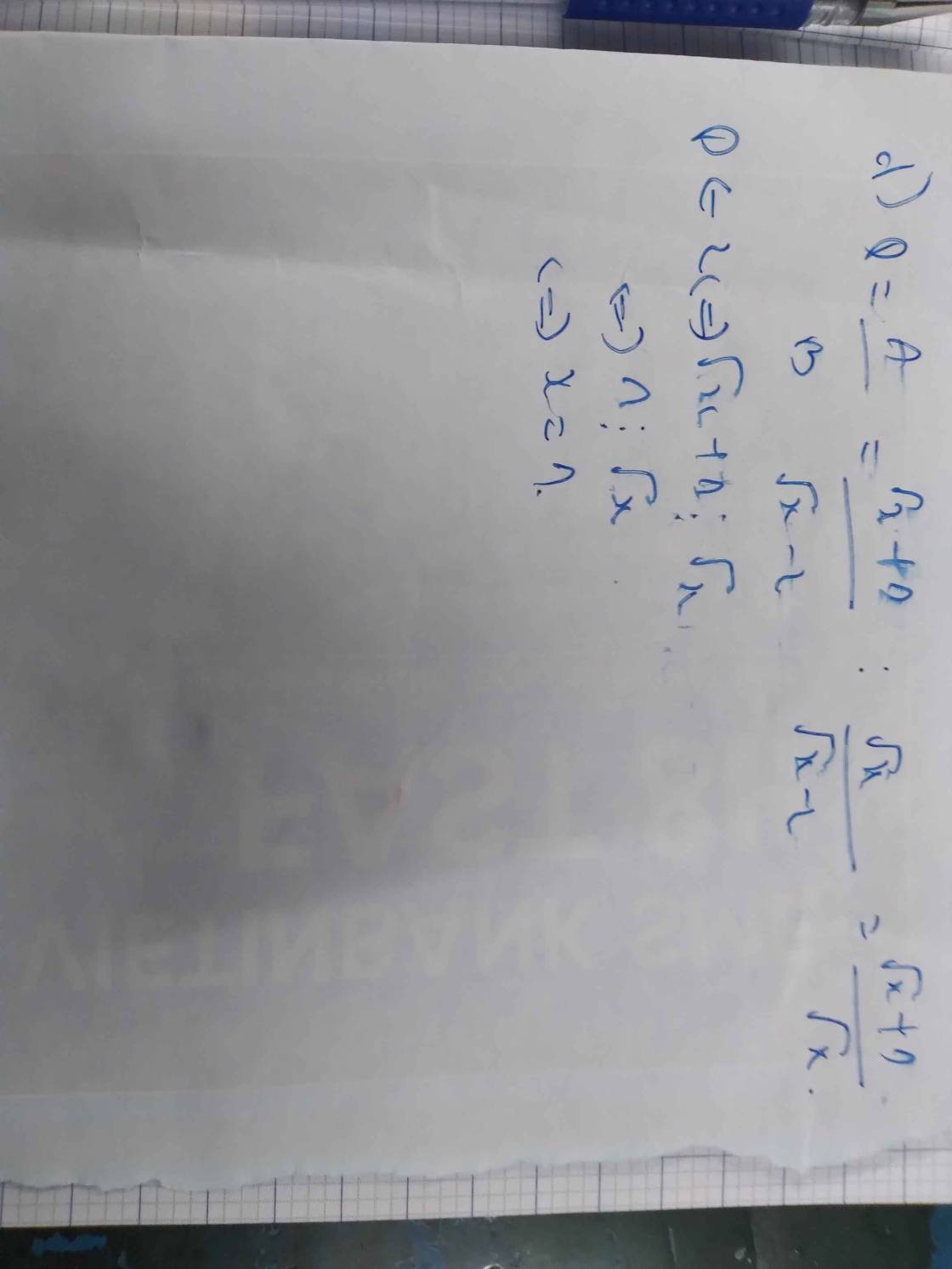Tính giá trị của biểu thức
Hãy nhập câu hỏi của bạn vào đây, nếu là tài khoản VIP, bạn sẽ được ưu tiên trả lời.

ĐKXĐ : \(x\ne0;x\ne\pm1\)
a) Bạn ghi lại rõ đề.
b) \(B=\dfrac{x-1}{x+1}+\dfrac{3x-x^2}{x^2-1}=\dfrac{x-1}{x+1}+\dfrac{3x-x^2}{\left(x-1\right).\left(x+1\right)}\)
\(=\dfrac{\left(x-1\right)^2+3x-x^2}{\left(x-1\right).\left(x+1\right)}=\dfrac{x+1}{\left(x-1\right).\left(x+1\right)}=\dfrac{1}{x-1}\)
c) \(P=A.B=\dfrac{x^2+x-2}{x.\left(x-1\right)}=\dfrac{\left(x-1\right).\left(x+2\right)}{x\left(x-1\right)}=\dfrac{x+2}{x}=1+\dfrac{2}{x}\)
Không tồn tại Min P \(\forall x\inℝ\)

a) A = (x - 5)(x² + 5x + 25) - (x - 2)(x + 2) + x(x² + x + 4)
= x³ - 125 - x² + 4 + x³ + x² + 4x
= (x³ + x³) + (-x² + x²) + 4x + (-125 + 4)
= 2x³ + 4x - 121
b) Tại x = -2 ta có:
A = 2.(-2)³ + 4.(-2) - 121
= 2.(-8) - 8 - 121
= -16 - 129
= -145
c) x² - 1 = 0
x² = 1
x = -1; x = 1
*) Tại x = -1 ta có:
A = 2.(-1)³ + 4.(-1) - 121
= 2.(-1) - 4 - 121
= -2 - 125
= -127
*) Tại x = 1 ta có:
A = 2.1³ + 4.1 - 121
= 2.1 + 4 - 121
= 2 - 117
= -115

a. Thay a = 14, b = 15, c = 10, ta có:
\(a=a\times b+200\)
\(=>a=14\times15+200\)
\(=>a=210+200=410\)
___
\(b=a\times b\times c\)
\(=>b=14\times15\times10=2100\)
b. Vì 410 < 2100 nên a < b.
\(#NqHahh\)
a: Khi a=14 và b=15 thì \(A=14\cdot15+200=210+200=410\)
Khi a=14 và b=15 và c=10 thì \(B=14\cdot15\cdot10=210\cdot10=2100\)
b: A=410
B=2100
=>A<B

Giá trị của biểu thức a + b × 2 với a = 8, b = 2 là:
a + b × 2 = 8 + 2 × 2 = 12
Giá trị của biểu thức (a + b) : 2 với a = 15, b = 27 là:
(a + b) : 2 = (15 + 27) : 2 = 21

a: \(A=\left(\dfrac{x}{x^2-4}+\dfrac{4}{x-2}+\dfrac{1}{x+2}\right):\dfrac{3x+3}{x^2+2x}\)
\(=\dfrac{x+4x+8+x-2}{\left(x-2\right)\left(x+2\right)}\cdot\dfrac{x\left(x+2\right)}{3\left(x+1\right)}\)
\(=\dfrac{6\left(x+1\right)\cdot x\left(x+2\right)}{3\left(x+1\right)\left(x-2\right)\left(x+2\right)}\)
\(=\dfrac{2x}{x-2}\)

Bài 5:
a: Thay \(x=4+2\sqrt{3}\) vào E, ta được:
\(E=\dfrac{\sqrt{3}+1-1}{\sqrt{3}+1-3}=\dfrac{\sqrt{3}}{\sqrt{3}-2}=-3-2\sqrt{3}\)
b: Để E<1 thì E-1<0
\(\Leftrightarrow\dfrac{\sqrt{x}-1-\sqrt{x}+3}{\sqrt{x}-3}< 0\)
\(\Leftrightarrow\sqrt{x}-3< 0\)
hay x<9
Kết hợp ĐKXĐ, ta được: \(\left\{{}\begin{matrix}0\le x< 9\\x\ne1\end{matrix}\right.\)
c: Để E nguyên thì \(4⋮\sqrt{x}-3\)
\(\Leftrightarrow\sqrt{x}-3\in\left\{-2;1;2;4\right\}\)
\(\Leftrightarrow\sqrt{x}\in\left\{4;5;7\right\}\)
hay \(x\in\left\{16;25;49\right\}\)
Câu 2:
a) Ta có \(x=4-2\sqrt{3}\Rightarrow\sqrt{x}=\sqrt{\left(\sqrt{3}-2\right)^2}=\sqrt{3}-2\)
Thay \(x=\sqrt{3}-1\) vào \(B\), ta được
\(B=\dfrac{\sqrt{3}-1-2}{\sqrt{3}-1+1}=\dfrac{\sqrt{3}-3}{\sqrt{3}}=1-\sqrt{3}\)
b) Để \(B\) âm thì \(\dfrac{\sqrt{x}-2}{\sqrt{x}+1}< 0\) mà \(\sqrt{x}+1\ge1>0\forall x\) \(\Rightarrow\sqrt{x}-2< 0\Rightarrow\sqrt{x}< 2\Rightarrow x< 4\)
c) Ta có \(B=\dfrac{\sqrt{x}-2}{\sqrt{x}+1}=1-\dfrac{3}{\sqrt{x}+1}\)
Với mọi \(x\ge0\) thì \(\sqrt{x}\ge0\Rightarrow\sqrt{x}+1\ge1\Rightarrow\dfrac{3}{\sqrt{x}+1}\le3\Rightarrow B=1-\dfrac{3}{\sqrt{x}+1}\ge-2\)
Dấu "=" xảy ra khi \(\sqrt{x}+1=1\Leftrightarrow x=0\)
Vậy \(B_{min}=-2\) khi \(x=0\)

a: Ta có: \(x^2=3-2\sqrt{2}\)
nên \(x=\sqrt{2}-1\)
Thay \(x=\sqrt{2}-1\) vào A, ta được:
\(A=\dfrac{\left(\sqrt{2}+1\right)^2}{\sqrt{2}-1}=\dfrac{3+2\sqrt{2}}{\sqrt{2}-1}=7+5\sqrt{2}\)


T = [ x 2 + ( a − b ) x − a b x 2 − ( a − b ) x − a b . x 2 − ( a + b ) x + a b x 2 + ( a + b ) x + a b ] : [ x 2 − ( b − 1 ) x − b x 2 + ( b + 1 ) x + b . x 2 − ( b + 1 ) x + b x 2 − ( 1 − b ) x − b ] = [ ( x − b ) ( x + a ) ( x − a ) ( x + b ) . ( x − a ) ( x − b ) ( x + a ) ( x + b ) ] : [ ( x − b ) ( x + 1 ) ( x + b ) ( x + 1 ) . ( x − 1 ) ( x − b ) ( x + b ) ( x − 1 ) ] = ( x − b ) 2 ( x + b ) 2 : ( x − b ) 2 ( x + b ) 2 = 1
Vậy T = 1
Đáp án cần chọn là: A